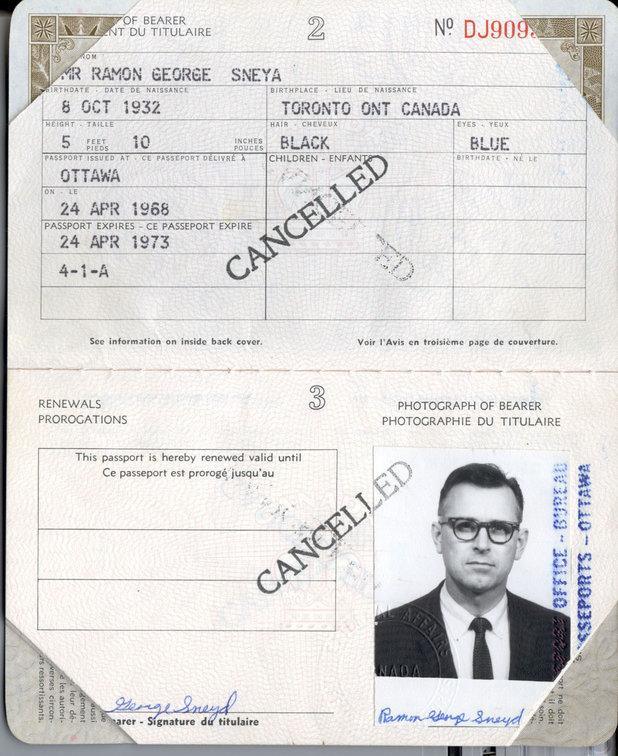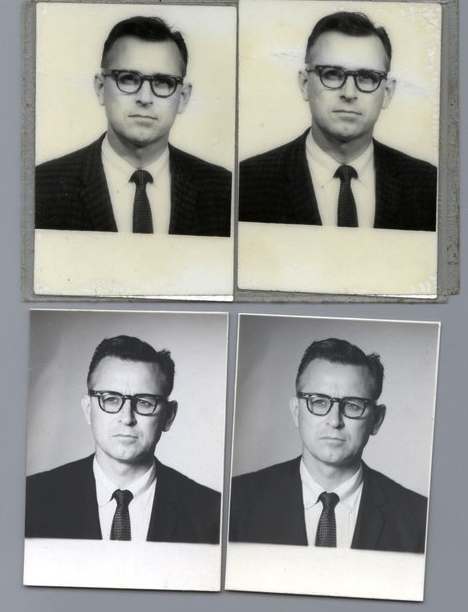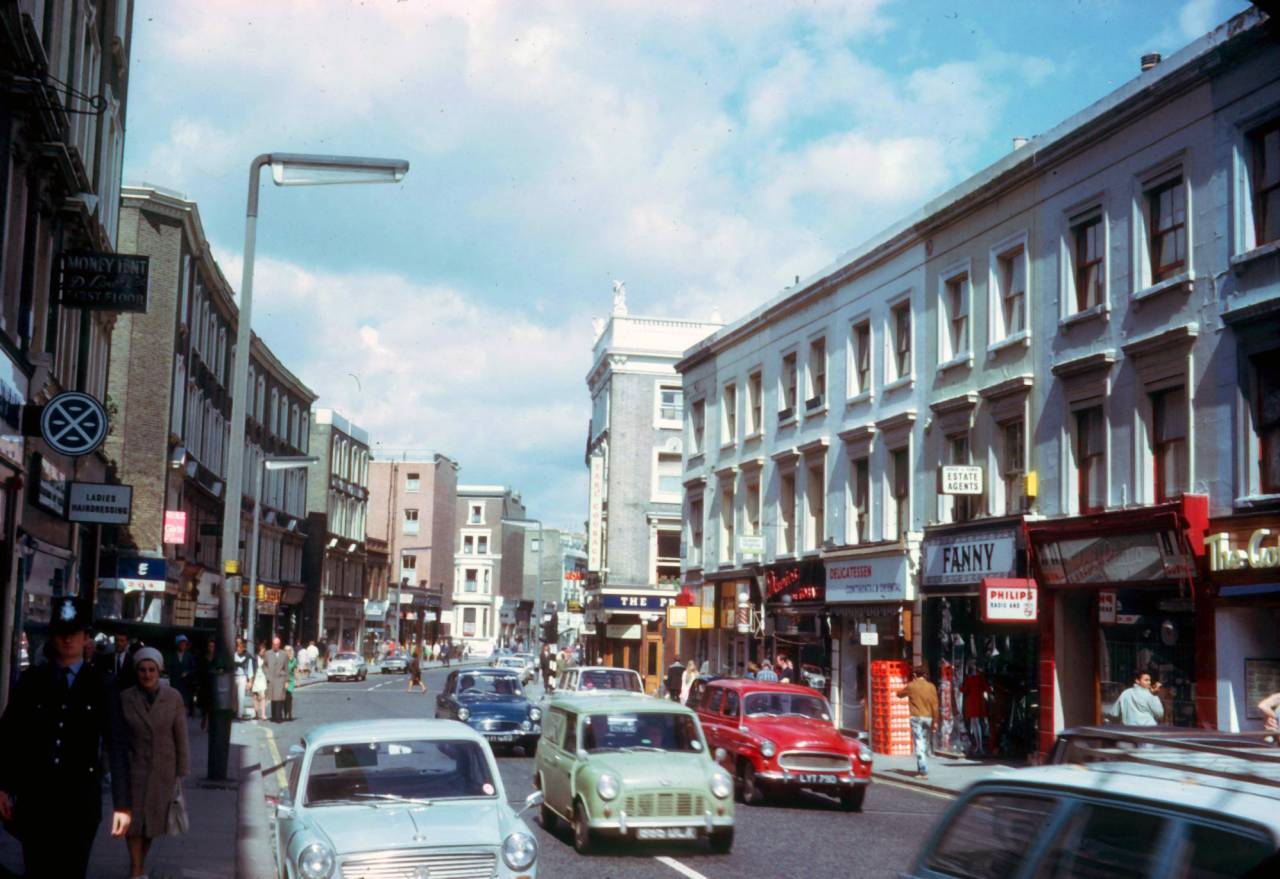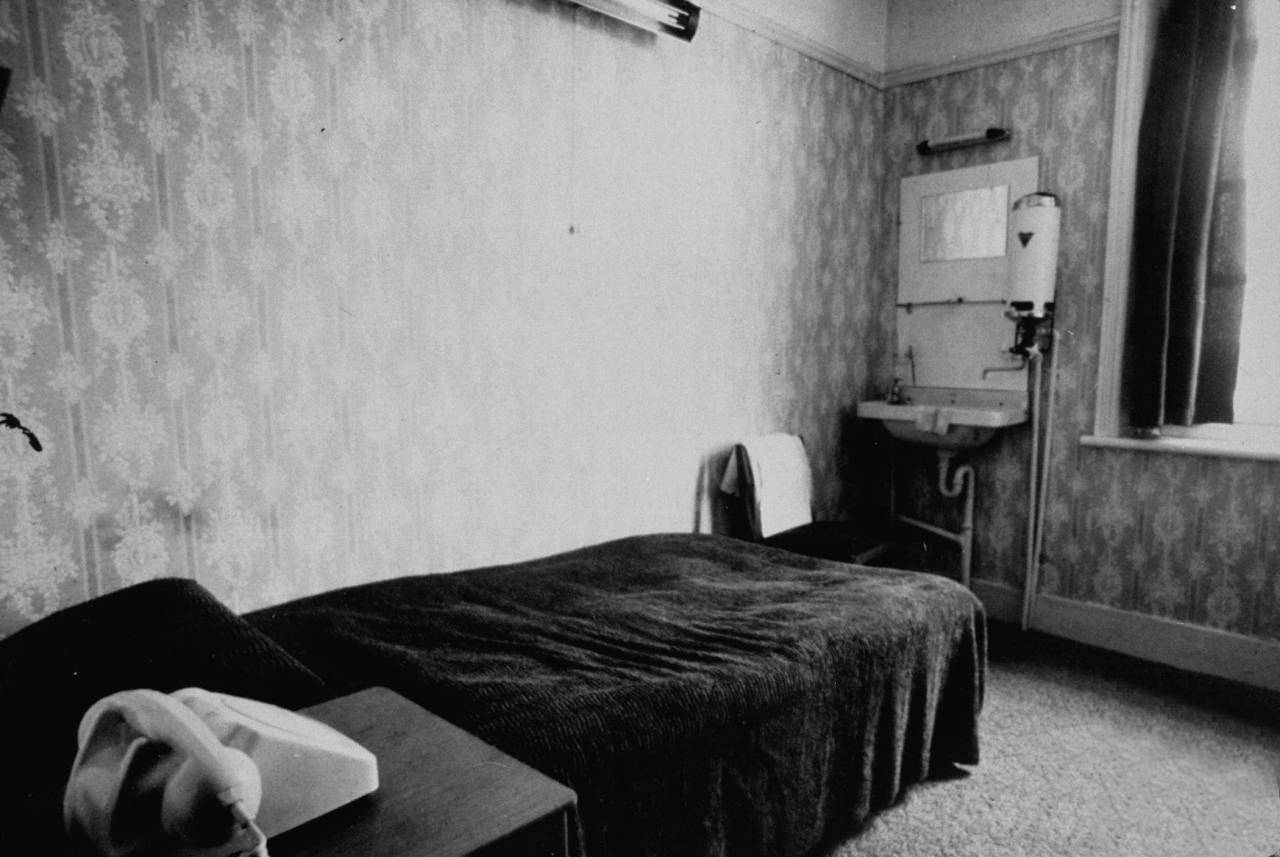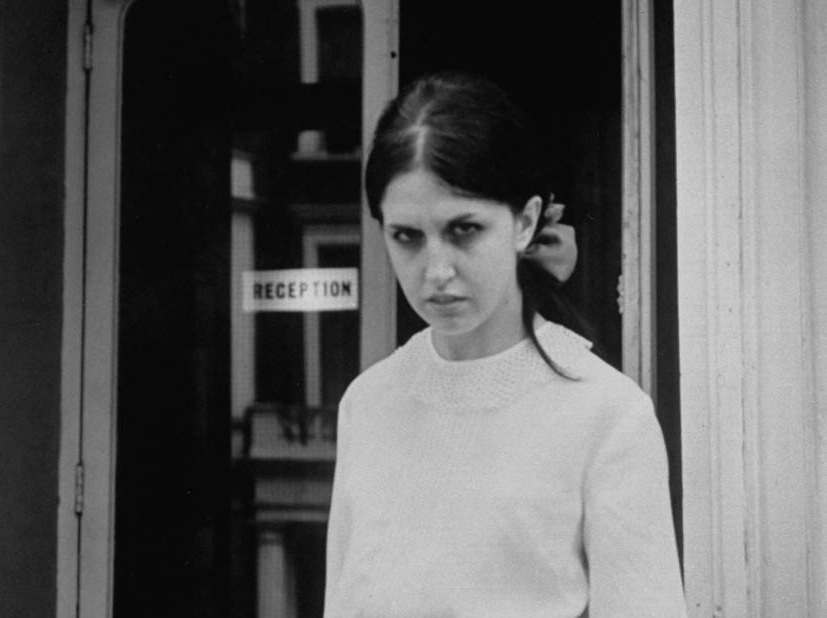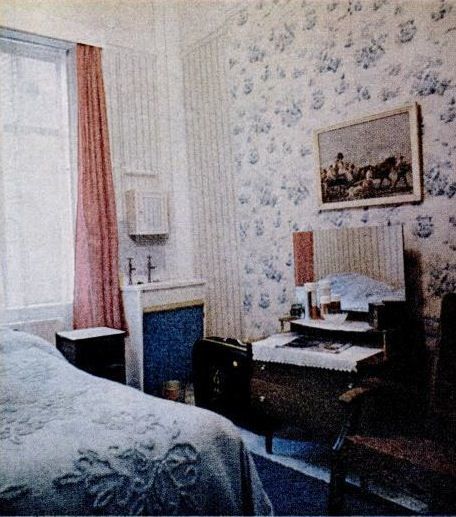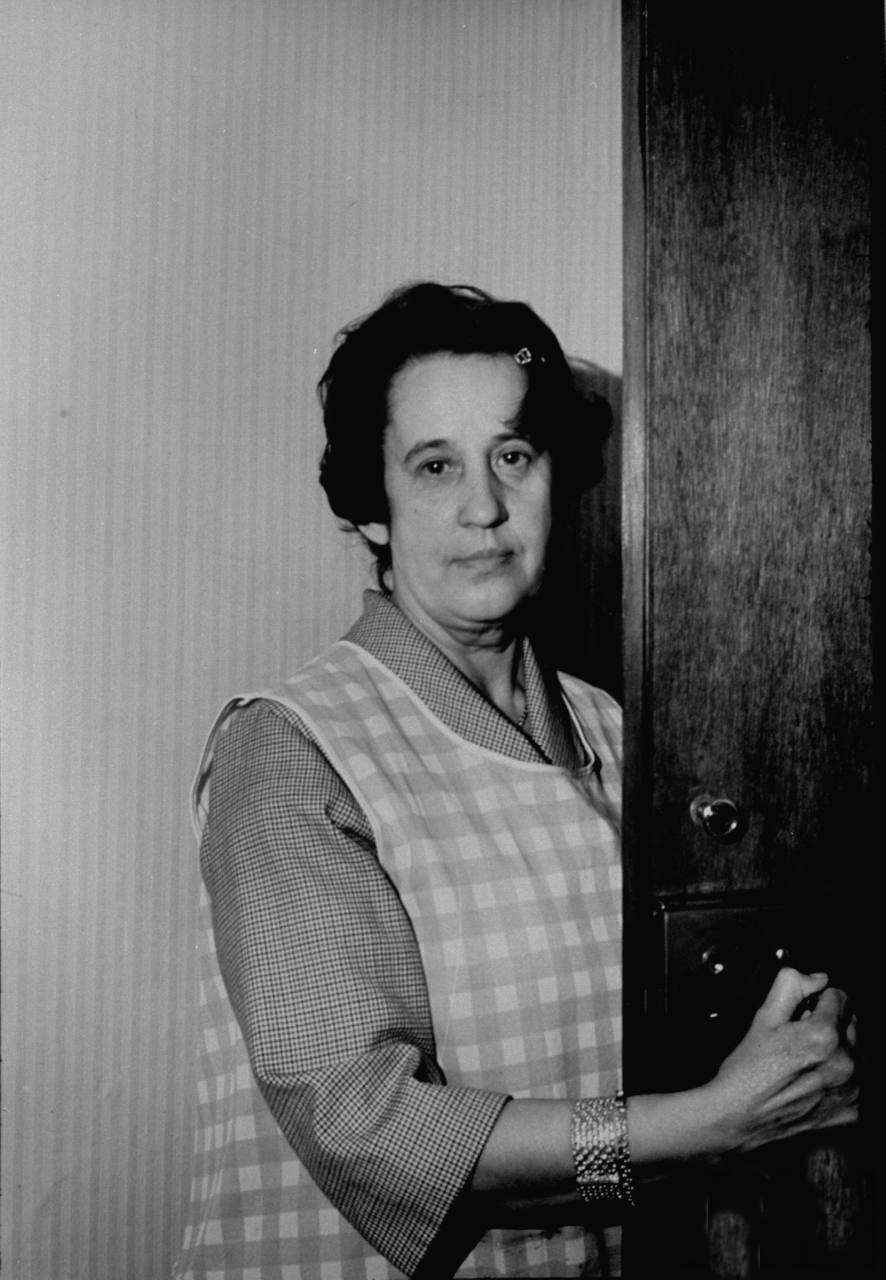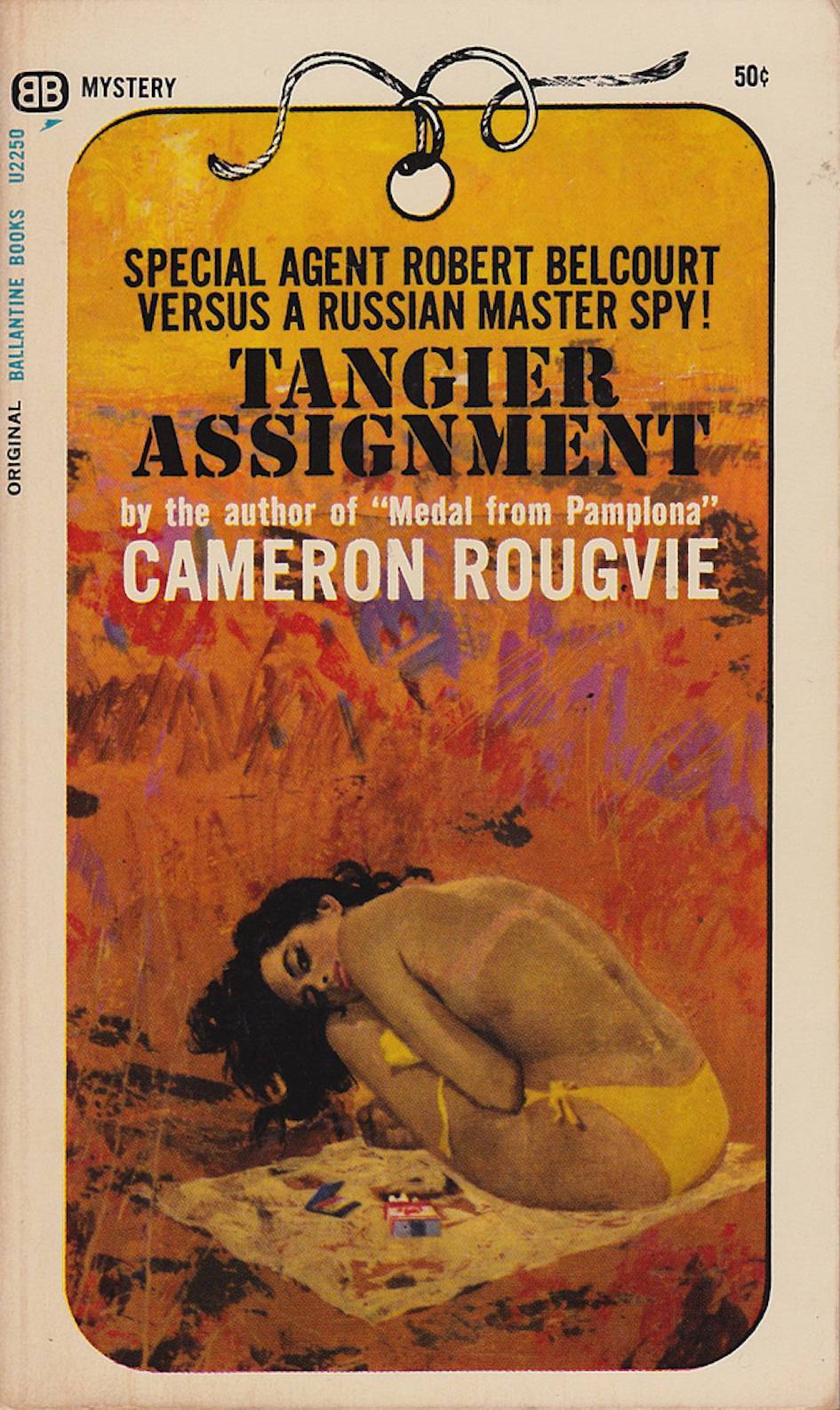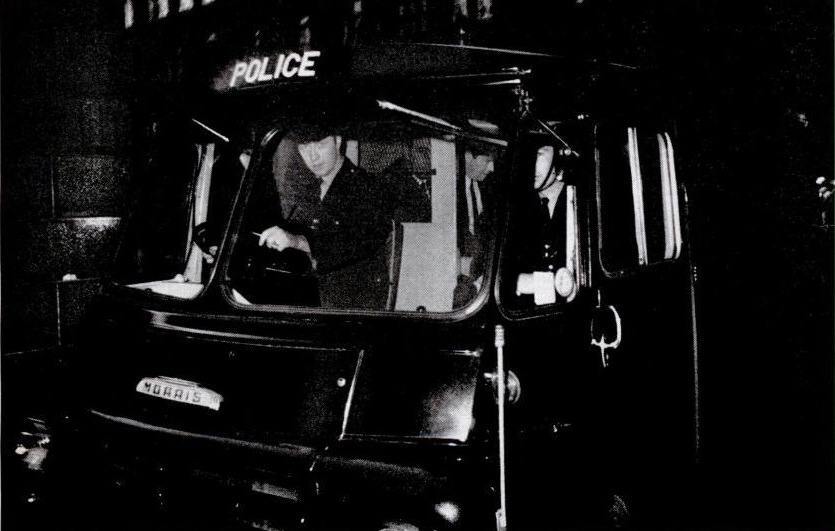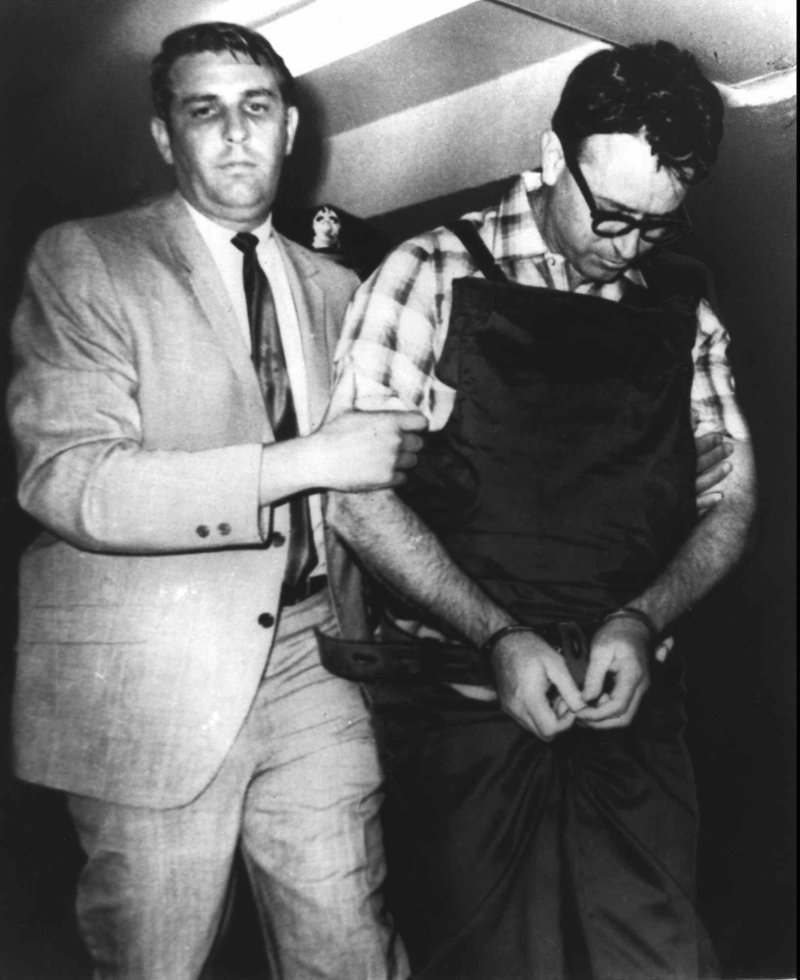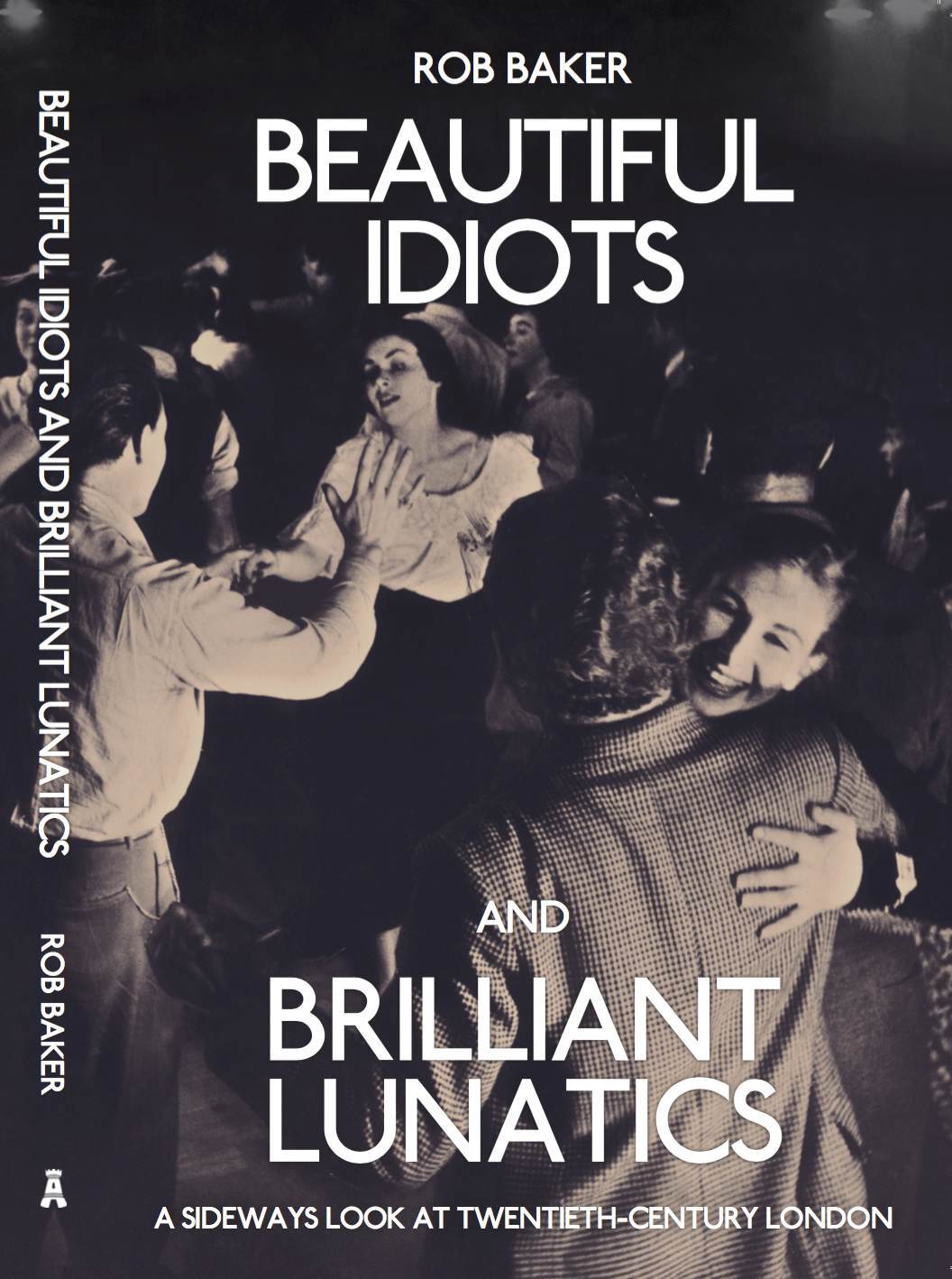At 11.15 on the morning of Saturday, June 8th 1968, and a few hours before the funeral of Robert Kennedy in New York City 3500 miles away, a man wearing a beige raincoat and tortoiseshell-rimmed glasses arrived at the passport desk inside the Europa Terminal at Heathrow Airport. It was only 35 minutes before his BEA Flight 466 to Brussels was due to take-off and he had already checked-in his luggage. As he got his passport out of his jacket, Ken Human, the immigration officer, noticed the passenger had a second passport and asked to see them both. The passports were almost identical except one had the name Sneyd whereas the other, issued in Ottawa, had the man’s surname as Sneya.
While the man was explaining that the first passport had accidentally been misspelt and that he had had another one issued while recently in Lisbon, they were suddenly joined by Detective Sgt. Philip Birch. The policeman looked at both the passports and then tapped the man on the shoulder and said:
I say, old fellow, would you mind stepping over here for a moment? I’d like to have a word with you.
The man who called himself Sneyd offered no protest and was led by the policeman into a nearby office. He was searched and a loaded Japanese-made Liberty Chief revolver, the handle of which was wrapped in black gaffer tape, was found stuffed in his back pocket. When Birch asked him why he was carrying a gun, the man replied:
Well, I’m going to Africa and I felt that I might need it. You know how things are, out there.
Birch immediately called Scotland Yard and it wasn’t long before Detective Chief Superintendent Tommy Butler was travelling towards Heathrow. He was known to the London’s criminal fraternity and beyond both as ‘One Day Tommy’ for the time he took apprehending criminals but also the ‘Grey Fox’ for his apparent shrewdness. When it came to publicity Butler was not prone to shyness and did little to discourage the use of his nicknames and he more than enjoyed the limelight. He was most notable for leading the team that investigated the Great Train Robbery in 1963 and when he arrived at London’s main airport he knew exactly whom he had come to arrest and soon the rest of the world did too.
The suspect was taken to Cannon Row police station part of the New Scotland Yard building designed by Norman Shaw. At this point he was still claiming that his name was Sneyd and that he was a Canadian citizen, born in Toronto. During the questioning, however, Butler told him that they believed he was the wanted man known as James Earl Ray and responsible for the murder of Dr Martin Luther King. The man, who until then had been standing, suddenly slumped down on the seat behind him and put his head in his hands and said, ‘Oh God’. A few moments later he added, ‘I feel so trapped.’
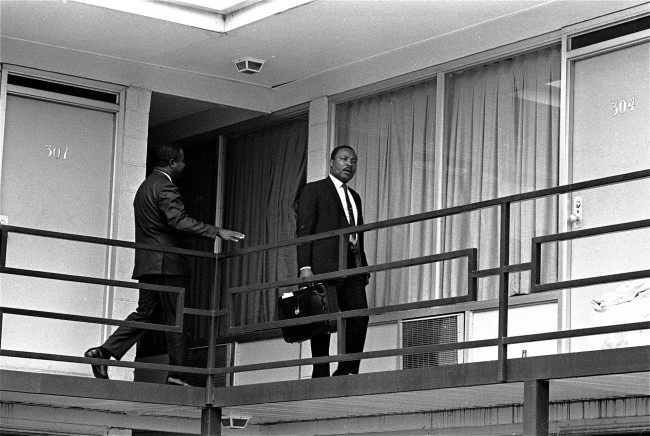
This April 3, 1968 file photo shows Rev. Martin Luther King, Jr. walking across the balcony of the Lorraine Motel in Memphis. The civil rights leader was standing on the balcony of the Lorraine Motel when he was killed by a rifle bullet on April 4, 1968.
Just over two months earlier on 4th April 1968 Dr King had been leaning over a second-floor balcony at the Lorraine motel in Memphis talking to his chauffeur, Solomon Jones, who was on the ground floor. A high velocity bullet suddenly hit King in the neck severing his spinal column and in less than an hour, at St Joseph’s hospital in Memphis, he died. The murder weapon, a Remington hunting rifle, was quickly found not more than a block away from the shooting. From the gun’s serial number and some clues in a White Mustang that had been seen leaving the scene it was quickly established, via a couple of pseudonyms, that the main suspect for the murder was a 40-year old man called James Earl Ray. At the time still an escapee from the Missouri State Penitentiary where he had been serving a 20-year sentence for armed robbery. The Daily Express, not inaccurately, would later describe Ray as ‘a petty, clumsy, stick-up man whose stupid mistakes had put him behind bars many times.’
Four days after he had fired the lethal bullet from the window of a boarding house across from the Lorraine Motel, James Earl Ray had already crossed the border into Canada. It was well known amongst many American prisoners, and Ray had been an habitual but unsuccessful criminal most of his adult life, that it was ludicrously easy to get a copy of a birth certificate in Ontario. Ray chose the name of a Toronto policeman Ramon George Sneyd, probably at random in a city directory. After mailing a two-dollar postal order he received within a few days a birth certificate with his new name. In an old newspaper in the Toronto library Ray found the maiden name of the original Sneyd’s mother and the relevant date of birth. All Ray now had to do was to swear that he was Canadian and ask for a passport. Within twenty-four hours Ray was on a BOAC plane to London and after a day continued on to Lisbon in Portugal.
At the time it was said to be the FBI’s largest and most expensive investigation in their history. Due to the amount of clues left behind they only had one suspect but had no real leads as to where he was. In the meantime however Ray was in Lisbon working out what to do. Ray by now probably assumed that people were on his trail and had gone to the Canadian consulate telling them that his name had been misspelled and asked ‘Sneyd’ to be changed to ‘Sneya’. The Canadian lackadaisical approach to passport issuing continued and with no questions asked Ray was given a replacement on 16 May. Running out of funds and realising that it would be far easier for him to operate in an English-speaking country he flew back to London the next day. He soon booked himself into a hotel called Heathfield House at 181-183 Cromwell Road on the outskirts of Earl’s Court for which he paid just over two pounds a night (approximately £32 in 2015) for the privilege.
Earl’s Court was an area of London known after the war as the ‘Danzig Corridor’ due to the amount of Polish people who had settled there. In the late forties there were 38,000-40,000 Poles living in and around London, then the largest foreign-born community in the capital. Twenty years later Earls Court was more likely to be called ‘Kangaroo Valley’ because of the large number of transient Australian and New Zealand travellers living there. At the time it was one of the cheapest areas to stay close to central London. There were also hundreds of cheap and seedy hotels and hostels so it was the perfect part of London to stay relatively anonymous. In 2015 Heathfield House is still a hotel but it is now called The Rockwell and any contemporary assassins needing a single room in 2015 would have to pay around £120 per night.
Ray stayed at Heathfield House for ten nights and after checking out walked down to the New Earl’s Court Hotel at 35-37 Penywern Road less than half a mile away. Penywern Road was a particularly shabby and run-down street in those days and the hotel, like the rest of the terrace, was made of London brick with the rendered parts covered in peeling dirty, white paint. Above the door was a blue awning. The receptionist at the hotel was called Jane Nassau and she remembered Ray staying there: ‘He was extremely shy, pathetically shy,’ she said, ‘He signed in as Canadian. But I thought it was strange. He had this deep southern drawl. He was extremely nervous.’ She also remembered explaining the British currency which had become even more confusing for a foreign traveller as some new 5p and 10p coins had been introduced a month or so before: ‘But he was a bit thick. It didn’t sink in.’ [2]
While Ray was still at the New Earl’s Court Hotel, On 1 June, the FBI had a break. At the Bureau’s request (they were of course also aware of Canada’s lax passport rules), the Royal Canadian Mounted Police had been laboriously checking three hundred thousand passport photos and eventually came across a picture that looked like the only real suspect for Martin Luther King’s murder – James Earl Ray.
Three days later, on the afternoon of Tuesday, 4 June and exactly two calendar months after Martin Luther King had been shot, Ian Colvin, a journalist in the Foreign newsroom of the Daily Telegraph, walked in to find a note at his typewriter which read: ‘A Mr Sneyd called, will call later.’ Ian Colvin as a journalist had begun his career on the News Chronicle as a correspondent in Berlin but had been expelled by the Nazis in 1939. During the fifties and sixties he worked as a foreign correspondent for the Daily Telegraph in Africa and the Middle East. At the time of his death, in 1975, he was the Telegraph’s chief leader writer. Ray did call Colvin later and this time the Telegraph journalist answered his phone. He heard a nervous voice say: ‘This is Ramon Sneyd. I want to join my brother who has been in Angola.’ Ray explained that he was a Canadian and had read Colvin’s articles about mercenaries in Africa. He wanted the telephone number of Major Alistair Wicks mentioned by Colvin and who had been second in command of the so-called 5 Commando Unit ANC a mercenary force in the Congo made up of about 300 men most of whom were from South Africa.
Ray claimed that his brother was missing and he hoped that Wicks might put him in touch with a group who could help locate him. Colvin was wary of giving out any information about Wicks who would have had plenty of enemies, and instead offered to pass along Sneyd’s number.
After Ray had called Colvin from a payphone a few feet from the desk in the hotel foyer, he asked Nassau about his bill for the first week. His money was now running out and he told her that he would have to go to his bank and make a withdrawal. Not long after this conversation Ray entered the Trustee Savings Bank at 179 Earls Court Road and less than five minutes walk away from his hotel. One of the cashiers looked up to see Ray wearing a blue suit, large sunglasses and a trilby hat. He pushed a small, pink paper bag toward her on which he’d written, ‘Place all £5-10 pound notes in this bag.’ The cashier noticed a gun between the fingers of one of his hands. She got £105 out of her drawer and pushed the notes towards him. Ray took the money and slowly walked out. He accidentally left the bag behind and later it was discovered it had his right thumbprint on it.
It was easy for Ray to make a quick escape from the area and he must have casually walked into Earls Court tube station literally across the road from the bank. He travelled four stops to Paddington and then came across a jewellers at 131 Praed Street called ‘Treasures’. The owners, Maurice and Billie Isaacs, then aged 61 and 57 respectively, were just closing up when Ray walked in. He produced his gun and expected the middle-aged couple to cower in fright. Instead Mr Isaacs quickly grabbed the pistol and managed to punch Ray in the face. Shocked the American went to leave but not before turning round at the doorway and pointing his gun at the jewellery shop owners who ducked behind the counter. The gun was never fired and Ray returned to his hotel.
Ray decided to check out of the New Earl’s Court Hotel and told Jane Nassau, falsely, that he was leaving for the airport. It was now raining heavily and clutching his bags Ray went out looking for another room. He initially tried the nearby YWCA at 118-120 Warwick Way, but although it did have rooms for men it was full and he was directed to the nearby Pax Hotel three doors down the same road at number 126. The Pax Hotel was then really a private house but its owner, Swedish-born Anna Thomas, let out several rooms and there was a small sign that simply read ‘hotel’ hanging down from a small first floor balcony. The building is now called the Bakers Hotel and a single room there in 2015 is around £85 per night.
When Thomas opened the door of her hotel Ray was standing there dripping wet in a beige raincoat, a suitcase in one hand and books and newspapers under his other arm. He introduced himself as Sneyd and said that he would take a room. Two days after the first call to Colvin, Ray called the journalist again complaining that he had not heard from Wicks. He let Colvin know that he had moved again and now he was at Hotel Pax. Colvin had passed on the message to Wicks but Wicks hadn’t recognised the name and not surprisingly, considering the world he moved in, had decided not to return the call. This time, however, Colvin questioned the caller and Ray admitted that his brother was not really missing but that he actually wanted to become a mercenary himself.
The call was continually being interrupted because Ray, unused to the British public phones was struggling to insert coins at the right moment. Colvin managed to tell him, however, that it wasn’t a good time to join any mercenary group and told him that both the British and Africans frowned on them these days. Colvin also told Ray that the place to get any information wasn’t London but Brussels. Although at the time Colvin found the stranger who kept calling him: ‘overwrought and somewhat incoherent’ he nonetheless sent a postcard to Pax Hotel suggesting that Sneyd contact the Belgian embassy.
At 9.30 am on Saturday, June 8 Anna Thomas knocked on ‘Ramon Sneyd’’s room and found that her tenant had packed up and disappeared. The room had been left clean except for a newspaper that featured Robert Kennedy’s assassination that had taken place two days before.
The day after Martin Luther King had died Robert Kennedy made a speech where he said ‘no martyr’s cause had ever been stilled by an assassin’s bullet’. Ray had also left behind a Cold War spy thriller called Assignment Tangier by Cameron Rougvie. The bright lurid cover featured a cross-legged woman in a yellow bikini the top of which was draped undone. The blurb talked of ‘international intrigue, Mafia villainy and free-booting contrabandists, helped by the lovely Sandra Grant’. Inside the back of the book was a mass of figures where Ray had tried to compare the value of dollars to pounds. In the sink, crammed down the spout, was a plastic syringe.
Thomas would later say that she was quite glad to see Ray leave: ‘he was so neurotic, such a strange fellow. I felt sorry for him but he was so obviously a troubled man that he gave me the creeps.’ [3] As Thomas cleaned the room, Ray was making his way to Heathrow Airport probably via the BEA terminal on the Cromwell Road where he could also check-in his luggage before being taken by coach to the Europa Terminal at Heathrow…
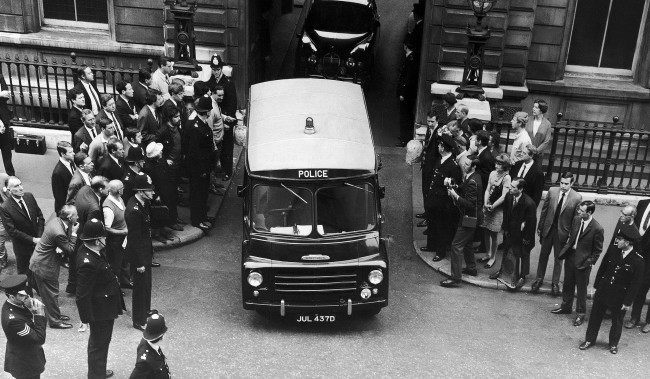
A Police van carrying Ramon George Sneyd, leaves Bow Street court in London, England on June 18, 1968, after the hearing. Ramon George Sneyd, said by American Police to be James Earl Ray, wanted for questioning in connection with the shooting of Dr. Martin Luther King, has been remanded in custody until June 27 when extradition proceedings will be heard. The hearing of the two British charges possession of a forced passport and a firearm and ammunition, without a certificate would be adjourned until the end of the extraction application.
James Earl Ray was held under heavy guard at Cannon Row where the security extended to sealing off the roads Cannon Row and Derby Gate. He was charged under the name Sneyd for possessing a forged passport and carrying a firearm without a permit. It wasn’t until 18th July, 40 days after his arrest at Heathrow airport, that the home secretary, James Callaghan was able to sign a Warrant of Surrender that authorised James Earl Ray’s extradition to the United States. Ray was taken to the United States Air force Base at Lakenheath in Suffolk and from there he was flown back to the USA at 12.38 am on Friday, 19th July 1968.
On March 10 1969 (his 41st birthday) at a hearing that lasted just 150 minutes James Earl Ray confessed to the assassination and pleaded guilty to save himself from the electric chair. Three days later he wrote a letter to the court asking that his plea be set aside (the judge refused the request) and he was sentenced to 99 years in prison.
In 1981 Ray was stabbed twenty times by a group of his fellow prisoners. After losing a lot of blood he contracted hepatitis during the subsequent blood transfusions. It was the hepatitis that eventually killed him. Ray died in prison in Nashville, Tennessee, on 23rd April 1998 just over thirty years after he had killed Dr Martin Luther King.
This is an excerpt from the book Beautiful Idiots and Brilliant Lunatics by Rob Baker.
Would you like to support Flashbak?
Please consider making a donation to our site. We don't want to rely on ads to bring you the best of visual culture. You can also support us by signing up to our Mailing List. And you can also follow us on Facebook, Instagram and Twitter. For great art and culture delivered to your door, visit our shop.


